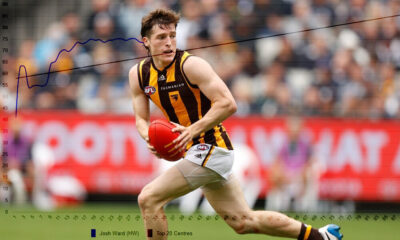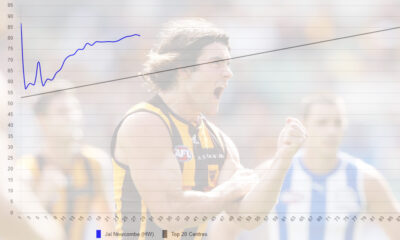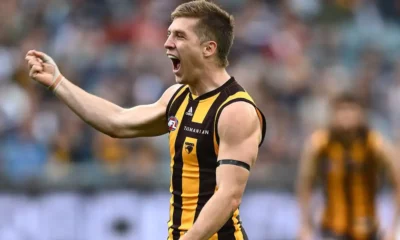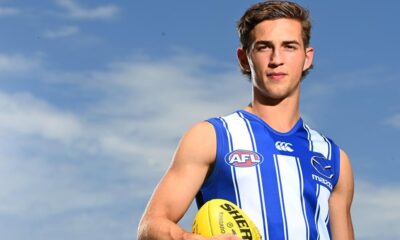
We’re all aware (or should be aware) that the number of interchanges a team can make during a game has been reduced to 75, down from the 90 of the previous 4 seasons. Combine this reduction with the return to full-length games, the common thought process is that there will be more players, particularly in the midfield, that will need to have to stay on the field and play in an alternative position. But are we placing too much emphasis on the impact this cap reduction will have on fantasy scores? Let’s delve into this a bit further.
First, let’s take a look at the recent history of the average number of interchanges in the AFL.
| Season | Average Number of Interchanges |
| 2006 | 46.5 |
| 2007 | 59.1 |
| 2008 | 80.3 |
| 2009 | 91.9 |
| 2010 | 117.4 |
| 2011 | 118.2 |
| 2012 | 130.9 |
| 2013 | 133.3 |
| 2014 | 117.3 |
| 2015 | 118.4 |
| 2016 | 95.5 |
| 2017 | 95.2 |
| 2018 | 94.1 |
In the 7 season period from 2006 to 2013, the average number of interchanges per team per game had steadily risen from an average of 46.5 interchanges in 2006 to 133.3 interchanges in 2013. The record for the most number of singles team interchanges in a single game was achieved by Adelaide in both Rounds 2 and 3 of the 2013 season with 169 interchanges. For season 2014, the AFL introduced a cap of 120 interchanges per team. For season 2016, that was reduced to 90 interchanges. The below table outlines the average number of interchanges per team per game from the 2006 season to the 2018 season.
For season 2021, the interchange cap has been reduced to 75. Interestingly, the AFL Commission reportedly received recommendation to cap the number of interchanges to 80.
Going from 90 down to 75 on the face of it sounds like a decent jump. But that reduction equates to 15 less interchanges per game, or 4 interchanges per quarter. To put that into perspective, there was a drop of 30 interchanges per game to the cap (not that it was strictly adhered to) or an average of 8 interchanges per quarter. Realising that, the 2021 interchange cap reduction doesn’t seem quite so bad. So how does this affect the players on the field?
For a player to come off the field for a rest on the pine, then return to the field, 2 interchanges are used up. Assuming each team will want to start each quarter with their best 18 players on the field, 2 players on the field will have one less trip to the pine per quarter. The question is, who are these 2 players from each team likely to be?
There are some player types we can already rule out as being one of the 2 players affected by the interchange cap. The high endurance midfield types like Andrew Gaff, Lachie Neale, and Jack Steele are already on the field for 100 minutes or more per game, and so are resting on the bench for 3-5 minutes per quarter. Key defensive and forward players like Harris Andrews, Dane Rampe, Tom Hawkins and Rory Lobb are on the field for about 110 minutes or more, thus rarely coming off the field during each quarter. You also have players from the midfield that already rotate to other positions of the ground as a bit of a rest such as Marcus Bontempelli, Tim Kelly, Patrick Dangerfield and Luke Parker.
I think the players that will be affected most by the reduced interchange cap will be the older short burst type players, namely those that play in the midfield but have less than 75% TOG, or spending up to 90 minutes on the ground each game. Players such as Nic Naitanui, Ollie Wines, Jed Anderson, Hugh Greenwood, Cam Guthrie. It’ll be these types of players that need to either improve their endurance, or find a second position on the field to play in order to increase their time on ground each game.
Below is a list of regular appearing players for each team that I’ve identified that will likely be one of those 2 players each quarter that will have one less trip to the interchange compared to their team mates (based on 2020 Time on Ground). This list is a mix of both the older, short-burst type players, as well as young upcoming players that will increase their TOG due to improved physical conditioning.
| Adelaide | Harry Schoenberg, Jackson Hately, Matt Crouch, Rory Sloane, |
| Brisbane | Jarrod Berry, Cam Rayner |
| Carlton | David Cunningham, Eddie Betts, Zac Williams |
| Collingwood | Jamie Elliot, Levi Greenwood, |
| Essendon | Jy Caldwell, Nick Hind |
| Fremantle | Andrew Brayshaw, Caleb Serong, Darcy Tucker, David Mundy, Hayden Young |
| Geelong | Brandan Parfitt, Cam Guthrie, Joel Selwood, Mitch Duncan |
| GWS | Bobby Hill, Jacob Hopper, Tom Green |
| Gold Coast | Hugh Greenwood, Matt Rowell, Noah Anderson, Rory Atkins, Will Powell |
| Hawthorn | Jack Scrimshaw, Jarman Impey, Jon Ceglar, Liam Shiels |
| Melbourne | James Harmes, Nathan Jones, Trent Rivers |
| North Melbourne | Jack Zieball, Jed Anderson, Jy Simpkin, Luke Davies-Uniacke |
| Port Adelaide | Ollie Wines, Sam Powell-Pepper, Travis Boak |
| Richmond | Jayden Short, Marlion Pickett, Toby Nankervis, Trent Cotchin |
| St Kilda | Brad Crouch, Dan Hannebery, Max King, Paddy Ryder |
| Sydney | James Rowbottom, Nick Blakely |
| West Coast | Jake Waterman, Oscar Allen, Nic Naitanui |
| Western Bulldogs | Aaron Naughton, Adam Treloar, Bailey Smith |
Of course, we won’t know exactly what the affect of the interchange cap will have on the fantasy footy world until the end of the season, but hopefully this gives you a little food for thought on who you should, and maybe shouldn’t, look to target in your drafts.














Bric
February 23, 2021 at 11:46 am
Drawing a long bow, but the last time interchanges were around this level, Buddy kicked a ton, Fev 99 plus Bradshaw, Roughead & Brown all kicked 70+. More scary is that only 5 players averaged over 100.
B3
March 1, 2021 at 8:28 pm
So we want to choose these players because their scores will go up relatively more than other players?